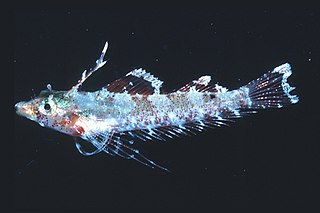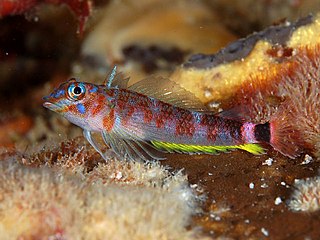
Yaldwyn's triplefin, Notoclinops yaldwyni, is a fish of the genus Notoclinops, found around the North Island of New Zealand from low water to depths of about 5 metres, most common in reef areas of broken rock, but nowhere common. Its length is between 4 and 8 centimetres. It is a pale yellow-brown with a faint orange tinge to the head, and two or three rows of small black dots on the flanks.
The mottled triplefin, Forsterygion malcolmi, is a triplefin of the genus Forsterygion, found around New Zealand at depths down to 30 m, in reef areas of broken rock. Its specific name honours Malcolm Francis of the Fisheries Research Centre in Wellington, New Zealand, who joined Hardy on his trips to collect specimens.

Ruanoho is a genus of triplefin blennies. It is known from the southwestern Pacific Ocean off New Zealand. The generic name is a compound noun derived from the Maori rua meaning either "fish" or "hole" and noho meaning to "dwell" which refers to the habit of the species in this genus to shelter under rocks or within crevices.

Bellapiscis lesleyae, the mottled twister, is a triplefin of the family Tripterygiidae, commonly found around the coast of New Zealand in rock pools and down to depths of about 5 m in reef areas of broken rock. Its length is up to 6 cm. The specific name of this blenny honours the New Zealand marine biologist Lesley Bolton who helped Hardy collect fishes in rockpools on the coast of New Zealand, including the type of this species.
The cryptic triplefin, Cryptichthys jojettae, is a triplefin of the family Tripterygiidae, the only member of the genus Cryptichthys, found around the coast of New Zealand. It length is up to 6 cm. The specific name honours a former staff member at the National Museum of New Zealand, Jorjette Drost, who participated in collecting specimens with Hardy.

Forsterygion is a genus of triplefins in the family Tripterygiidae native to coastal New Zealand, but also introduced to Tasmania, Australia.
Lepidonectes is a genus of triplefins in the family Tripterygiidae. They are found in the eastern Pacific Ocean.

Norfolkia is a genus of triplefins in the family Tripterygiidae. They are found I the Indo-Pacific region.

Springerichthys is a genus of triplefins in the family Tripterygiidae. The two species in this genus are found in the western Pacific Ocean.

The largemouth triplefin, Ucla xenogrammus, is a fish of the family Tripterygiidae and only member of the genus Ucla, found in the Pacific Ocean from Viet Nam, the Philippines, Palau and the Caroline Islands to Papua New Guinea, Australia, and the Solomon Islands, Fiji, Tonga, east to American Samoa and Rapa Iti, at depths of between 2 and 41 metres. Its length is up to about 47 millimetres (1.9 in). The generic name was coined by ichthyologist Richard Heinrich Rosenblatt in his unpublished dissertation of 1959 from the University of California Los Angeles and its is the initials of that institution, it was formally applied by Holleman in 1993.

Enneapterygius tutuilae, known commonly as the high-hat triplefin or rosy cheek threefin, is a species of triplefin blenny in the genus Enneapterygius. It was described by David Starr Jordan and Alvin Seale in 1906. This species occurs from the eastern Indian Ocean around the Cocos (Keeling) Islands east to French Polynesia. Its specific name refers to the Samoan island of Tutuila where the type was collected.
Enneapterygius hollemani, or Holleman's triplefin, is a species of triplefin blenny in the genus Enneapterygius. It is found only on the central and southern coasts of Oman. It was described by John E. Randall in 1995 and was named in honour of the ichthyologist Wouter Holleman of the South African Institute for Aquatic Biodiversity.
Enneapterygius larsonae, known commonly as the Western Australian black-head triplefin, is a species of triplefin blenny in the genus Enneapterygius. It was described by the German ichthyologist Ronald Fricke in 1994. The specific name honours Helen K. Larson, the Curator of Fishes at the Museum and Art Gallery of the Northern Territory in Darwin, Australia, who collected the type.

Enneapterygius mirabilis, the miracle triplefin, is a species of triplefin blenny in the genus Enneapterygius. It was described by Ronald Fricke in 1994 who gave it the specific name mirabilis, meaning "admirable", because its notable large pectoral fins and first dorsal fin were pretty.

Enneapterygius senoui is a species of triplefin blenny in the genus Enneapterygius. It was described by Hiroyuki Motomura, Shigeru Harazaki and Graham S. Hardy in 2005. The specific name honours Hiroshi Senou of the Kanagawa Prefectural Museum of Natural History, the collector of the holotype and four of the paratypes, making them available for study by the authors. It is found in the western Pacific Ocean off the Izu Islands and the Ogasawara Islands off southern Japan.

Helcogramma hudsoni, known commonly as the Hudson's triplefin, is a species of triplefin blenny in the genus Helcogramma. It was described by David Starr Jordan and Alvin Seale in 1906, the specific name honouring the illustrator of their monograph on Samoan fishes, R.L. Hudson. This species is found in the western Pacific Ocean where it has been recorded from the Izu Islands, Ryukyu Islands, Savo Island, New Caledonia, Vanuatu, Fiji, and Samoa.
Cunningham's triplefin is a species of triplefin blenny in the genus Helcogrammoides. It was described by Frederik Adam Smitt in 1898, who named it in honour the Scottish naturalist Robert Oliver Cunningham (1841-1918), who had collected specimens of this fish from Puerto Madryn in 1868 but was unable to identify them. This species has been found in Peru, near Lima, Chile, Puerto Madryn in Argentina and the Falkland Islands.
Lepidonectes clarkhubbsi, known commonly as the signal triplefin, is a species of triplefin blenny in the genus Lepidonectes. It was described by William Albert Bussing in 1991 and he gave it a specific name which honours the American ichthyologist Clark Hubbs (1921–2008). This species occurs in the eastern Pacific Ocean where it is found off Costa Rica and Panama. The signal triplefin is found on rocky shores where it feeds on very small invertebrates and algae.
Matanui is a genus of triplefin blennies, they are endemic to New Zealand.
Norfolkia leeuwin, known commonly as the Leeuwin triplefin, is a species of triplefin blenny in the genus Norfolkia. It was described by Ronald Fricke in 1994. This species is found in the southern part of the coast of West Australia from the Houtmon's Abrolhos Islands to the Recherche Archipelago. It is found in rocky reefs. Its specific name references the Leeuwin Current which influences the coastal areas in which this fish occurs.











